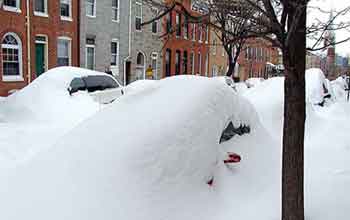Media Advisory 04-35
Answer to How Winter Seasonal Forecasts Can Be Improved May Be Found in Siberia's Autumn Snows
November 9, 2004
This material is available primarily for archival purposes. Telephone numbers or other contact information may be out of date; please see current contact information at media contacts.
Energy prices are at all-time highs, so winter weather, which significantly affects the U.S. economy, may have an even greater impact this season.
National Science Foundation (NSF)-funded research by Judah Cohen of Atmospheric and Environmental Research (AER), Inc., in Lexington, Massachusetts, has led to the development of an experimental model, which may offer improved winter weather forecasts. Such forecasts can help guide planning for dealing with winter weather impacts.
Most forecast models rely exclusively on global ocean temperatures for seasonal predictions, with a strong emphasis on tropical ocean temperatures in the Pacific associated with the El Niño. El Nino has been linked with surface temperature and precipitation patterns across the globe. However, the predictive power of El Nino is limited by its infrequent appearance, only once in every four or five years. In years when El Nino is absent, weak, or even moderately strong, its use as a predictor of upcoming winter weather has met with variable success.
Using data from the land surface and the lower atmosphere, which are largely ignored by other forecast models, Cohen has found clues to upcoming winter conditions in the U.S. and Europe. Cohen pays particular attention to autumn snowfall amounts in Siberia, which, he maintains, have the potential to exert a major influence on winter climate. Satellite-observed snow cover departures from average are therefore incorporated into Cohen's prediction model.
Cohen cautions that he has produced a limited number of real-time forecasts, and that it is premature to draw any definitive conclusions, but early successes show significant potential. Striking examples of these successes include the last two winters: For 2002-03, Cohen correctly predicted cold weather in the eastern U.S., while most government and private forecasters anticipated warm temperatures, their predictions based largely on El Niño conditions. Cohen's model also anticipated a cold winter for the northeastern U.S. for the 2003-04 season, while official forecast centers predicted an equal chance of warm, cold or normal conditions.
Cohen will talk about the basis for his seasonal winter forecasts and how they differ from current methods.
|
Who: |
Scientist Judah Cohen, AER, Inc. |
|
What: |
Talk on Winter Seasonal Forecasts |
|
When: |
Wednesday, November 17, 2004 |
|
Where: |
National Science Foundation |
-NSF-
Media Contacts
Cheryl L. Dybas, NSF, (703) 292-7734, email: cdybas@nsf.gov
The U.S. National Science Foundation propels the nation forward by advancing fundamental research in all fields of science and engineering. NSF supports research and people by providing facilities, instruments and funding to support their ingenuity and sustain the U.S. as a global leader in research and innovation. With a fiscal year 2023 budget of $9.5 billion, NSF funds reach all 50 states through grants to nearly 2,000 colleges, universities and institutions. Each year, NSF receives more than 40,000 competitive proposals and makes about 11,000 new awards. Those awards include support for cooperative research with industry, Arctic and Antarctic research and operations, and U.S. participation in international scientific efforts.
Connect with us online
NSF website: nsf.gov
NSF News: nsf.gov/news
For News Media: nsf.gov/news/newsroom
Statistics: nsf.gov/statistics/
Awards database: nsf.gov/awardsearch/
Follow us on social
Twitter: twitter.com/NSF
Facebook: facebook.com/US.NSF
Instagram: instagram.com/nsfgov



